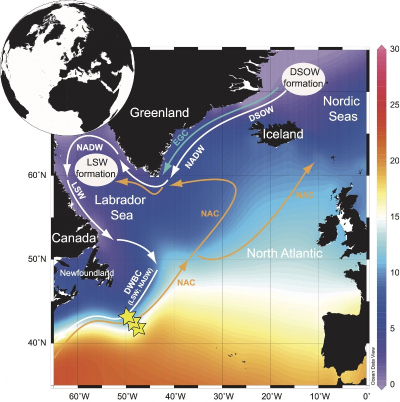Dr. Lars Max
Archived PageThis web page has not been updated since the former colleague left MARUM. |
Research Topics
• The subpolar oceans in the climate system
• Pleistocene to Holocene development of the subpolar Pacific
• Paleoceanography of the subpolar Atlantic
• High- and low-latitude atmosphere-ocean interactions
Current DFG Project
Links between subpolar Northwest Atlantic surface to deep ocean variability and Atlantic Meridional Overturning Circulation since the Last Glacial Maximum
As one of the main regions of deep-water formation, the subpolar Northwest Atlantic is a crucial component of the Atlantic Meridional Overturning Circulation (AMOC). In particular, wintertime convection of surface waters leads to formation of Labrador Sea Water (LSW) that forms the upper limb of North Atlantic Deep Water (NADW) and plays a central role in the modern AMOC (Fig. 1). Several studies based on instrumental data suggest AMOC weakening in response to anthropogenic warming and surface freshening in the subpolar Atlantic and Labrador Sea. However, instrumental observations are temporally limited to the past decades only and our understanding of long-term variability and driving mechanisms of AMOC on millennial- to multi- centennial timescales remains incomplete. Paleoclimate proxy records, such as those derived from marine sediments, offer a unique opportunity to investigate past surface to deep ocean variability of the subpolar North Atlantic on much longer timescales and to gain our understanding of AMOC behaviour under changing climate boundary conditions. In this study, we will use an innovative approach via contemporaneous reconstructions of surface and deep- water hydrography on multi-centennial timescales from NW Atlantic high-resolution sediment cores collected on MARIA S. MERIAN Expedition MSM39 in 2014 (Fig. 1). We will focus on the last 24,000 cal yr BP, a time period that covers past major and abrupt changes in AMOC related to episodic meltwater flux events (Heinrich Events), to further investigate mechanisms behind natural AMOC perturbations and to derive potential benchmarks for future AMOC stability and climate.

Selected Publications
Max, L., Lembke-Jene, L., Zou, J., Shi, X., Tiedemann, R. (2020). Evaluation of reconstructed sea surface temperatures based on Uk′37 from sediment surface samples of the North Pacific. Quaternary Science Reviews, 243, 106496. https://doi.org/10.1016/j.quascirev.2020.106496
Pöppelmeier, F., Blaser, P., Gutjahr, M., Jaccard, S.L., Frank, M., Max, L., Lippold, J. (2020). Northern-sourced water dominated the Atlantic Ocean during the Last Glacial Maximum. Geology, 48 (8), 826-829. https://doi.org/10.1130/G47628.1
Rippert, N., Max, L., Mackensen, A., Cacho, I., Povea, P., & Tiedemann, R. (2017). Alternating influence of northern versus southern-sourced water masses on the equatorial Pacific sub-thermocline during the past 240 ka. Paleoceanography, 32. https://doi.org/10.1002/2017PA003133
Ovsepyan, E.A., Ivanova, E.V., Lembke-Jene, L., Max, L., Tiedemann, R., Nürnberg, D. (2017). Penultimate and last glacial oceanographic variations in the Bering Sea on millennial timescales: links to North Atlantic Climate. Quaternary Science Reviews, 163, 135-151. http://dx.doi.org/10.1016/j.quascirev.2017.03.012
Max, L., Rippert, N., Lembke-Jene, L., Tiedemann, R., Cacho, I., Mackensen, A., Nürnberg, D. (2017). Enhanced convection of North Pacific Intermediate Water to the low-latitude Pacific under glacial conditions. Paleoceanography, 32. https://doi.org/10.1002/2016PA002994


